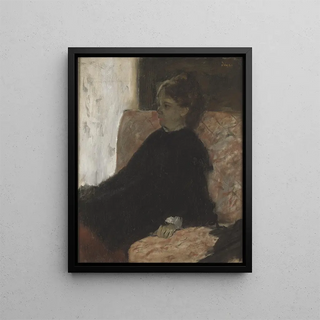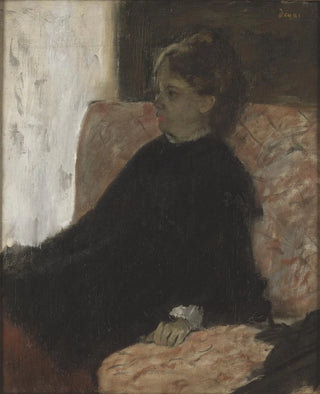Art print | Lady in Black - Edgar Degas


View from behind

Frame (optional)
Reproduction Dame en noir - Edgar Degas – Engaging Introduction
The canvas "Dame en noir" by Edgar Degas, created at the end of the 19th century, embodies a captivating encounter between modernity and tradition. This artwork, emblematic of the Impressionist movement, depicts a mysterious woman draped in a dark dress, seemingly lost in her thoughts. The subtle play of light and shadow, along with the dynamic composition, captivates the viewer and invites reflection on the female condition of that era. The art print of this piece allows not only appreciation of Degas's technical virtuosity but also immersion into the intimate and melancholic atmosphere emanating from the painting.
Style and uniqueness of the work
Degas's style is distinguished by his ability to capture the moment, to seize fleeting instances of everyday life. In "Dame en noir," the woman's posture, slightly in profile, suggests deep introspection. The dark color palette, dominated by black, is enhanced by touches of light that highlight the details of the dress and face. This contrast creates a visual tension that draws the eye and stimulates the imagination. Degas, a master of movement, manages to infuse dynamism into his subjects, even in a static pose. The pastel technique, which the artist particularly favors, gives the work a soft, velvety texture, adding to its undeniable charm. This stylistic singularity makes "Dame en noir" an unforgettable artwork that continues to inspire and move viewers.
The artist and his influence
Edgar Degas, an iconic figure of Impressionism, transcended the artistic conventions of his time. Born in Paris in 1834, he was initially trained at the Académie des Beaux-Arts before turning to more contemporary subjects, such as ballet scenes, cafés, or urban life. His fascination with movement and capturing light revolutionized painting of his era. Degas was also influenced by photography, which is reflected in his bold compositions and unexpected angles. His work paved the way for many artists, making

Matte finish

View from behind

Frame (optional)
Reproduction Dame en noir - Edgar Degas – Engaging Introduction
The canvas "Dame en noir" by Edgar Degas, created at the end of the 19th century, embodies a captivating encounter between modernity and tradition. This artwork, emblematic of the Impressionist movement, depicts a mysterious woman draped in a dark dress, seemingly lost in her thoughts. The subtle play of light and shadow, along with the dynamic composition, captivates the viewer and invites reflection on the female condition of that era. The art print of this piece allows not only appreciation of Degas's technical virtuosity but also immersion into the intimate and melancholic atmosphere emanating from the painting.
Style and uniqueness of the work
Degas's style is distinguished by his ability to capture the moment, to seize fleeting instances of everyday life. In "Dame en noir," the woman's posture, slightly in profile, suggests deep introspection. The dark color palette, dominated by black, is enhanced by touches of light that highlight the details of the dress and face. This contrast creates a visual tension that draws the eye and stimulates the imagination. Degas, a master of movement, manages to infuse dynamism into his subjects, even in a static pose. The pastel technique, which the artist particularly favors, gives the work a soft, velvety texture, adding to its undeniable charm. This stylistic singularity makes "Dame en noir" an unforgettable artwork that continues to inspire and move viewers.
The artist and his influence
Edgar Degas, an iconic figure of Impressionism, transcended the artistic conventions of his time. Born in Paris in 1834, he was initially trained at the Académie des Beaux-Arts before turning to more contemporary subjects, such as ballet scenes, cafés, or urban life. His fascination with movement and capturing light revolutionized painting of his era. Degas was also influenced by photography, which is reflected in his bold compositions and unexpected angles. His work paved the way for many artists, making






